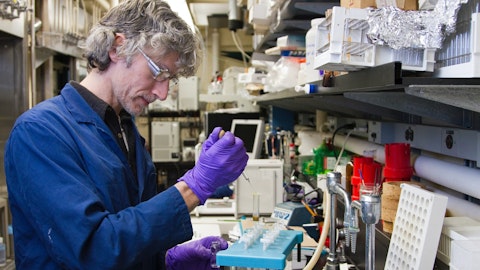Medpace Holdings, Inc. (NASDAQ:MEDP) Q1 2023 Earnings Call Transcript April 25, 2023
Medpace Holdings, Inc. beats earnings expectations. Reported EPS is $2.27, expectations were $1.8.
Operator: Good day, ladies and gentlemen, and welcome to the Medpace First Quarter 2023 Earnings Conference Call. At this time, all participants are in a listen-only mode. Later, we will conduct a question-and-answer session and instructions will follow at that time. As a reminder, this call may be recorded. I would now like to introduce your host for today’s conference call, Lauren Morris, Medpace’s Director of Investor Relations. You may begin.
Lauren Morris: Good morning. And thank you for joining Medpace’s first quarter 2023 earnings conference call. Also on the call today is our CEO, August Troendle; our President, Jesse Geiger; and our CFO, Kevin Brady. Before we begin, I would like to remind you that our remarks and responses to your questions during this teleconference may include forward-looking statements within the meaning of the Private Securities Litigation Reform Act of 1995. These statements involve inherent assumptions with known and unknown risks and uncertainties, as well as other important factors that could cause actual results to differ materially from our current expectations. These factors are discussed in our Form 10-K and other filings with the SEC.
Please note that we assume no obligation to update forward-looking statements, even if estimates change. Accordingly, you should not rely on any of today’s forward-looking statements as representing our views as of any date after today. During this call, we will also be referring to certain non-GAAP financial measures. These non-GAAP measures are not superior to or a replacement for the comparable GAAP measures, but we believe these measures help investors gain a more complete understanding of results. A reconciliation of such non-GAAP financial measures to the most directly comparable GAAP measures is available in the earnings press release and earnings call presentation slides provided in connection with today’s call. The slides are available in the Investor Relations section of our website at investor.medpace.com.
With that, I would now like to turn the call over to August Troendle.
August Troendle: Thank you Lauren. Business environment improved in Q1 with RFP flow up on a sequential and year-over-year basis. The total dollar value of pending RFPs also improved significantly. Although word notifications were down on the quarter, they showed sequential improvement January to February to March, and have improved even further to a relatively strong level in the first three weeks of April. Total pipeline cancellations were down over 50% on a sequential basis in Q1. The trends at this point look favorable. And we are cautiously optimistic about our backlog build toward 2024. We’re raising 2023 guidance in line with our strong financial performance in Q1 and greater visibility we now have into the full year results. Jessie and Kevin will now review Q1 financial results in detail and our updated 2023 guidance.

Research, Investment, Finance
Jesse Geiger: Thank you, August. And good morning, everyone. Our revenue in the first quarter of 2023 was $434.1 million, which represents a year-over-year increase of 31.2%. Net new business awards entering backlog in the first quarter increased 31.4% from the prior year to $555.8 million, resulting in 1.28% net book-to-bill. Ending backlog as of March 31 was approximately $2.5 billion, which was an increase of 17.8% from the prior year. We project that approximately $1.33 billion of backlog will convert to revenue in the next 12 months. And backlog conversion in the first quarter was 18.6% of beginning backlog. In 2023, we continued to make progress in hiring in the first quarter, adding 4.3% from the end of 2022 and over 15.8% from the prior year.
Employee retention and continued hiring for future business will remain top priorities in 2023. And with that, I will turn the call over to Kevin to review our financial performance in more detail and discuss our 2023 guidance. Kevin?
Kevin Brady: Thank you Jesse and good morning to everyone listening in. As Jesse mentioned, revenue was $434.1 million in the first quarter of 2023. This represented a year-over-year increase of 31.2% on a reported basis and 31.8% on a constant currency basis. The strong revenue results for the quarter reflected less funding challenges than anticipated for our clients. EBITDA of $92.8 million increased 31.9% compared to $70.4 million in the first quarter of 2022. On a constant currency basis, EBITDA for the first quarter increased 28.6% compared to the prior year. EBITDA margin for the first quarter was 21.4% compared to 21.3% in the prior year periods. EBITDA margin for the quarter was positively impacted by the strong revenue.
We anticipate margin headwinds the balance of the year as a result of wage inflation, headcount gross, entire reimbursable costs as a proportion of total revenue. In the first quarter of 2023, net income of $72.9 million increased 18.9% compared to net income of $61.3 million in the prior year period. Net income growth lagging EBITDA was primarily driven by a higher effective tax rate of 15.3% compared to 6.1% in the prior year period. Net income per diluted share for the quarter was $2.27 compared to $1.69 in the prior year period. Regarding customer concentration, our top five and top 10 customers represent roughly 22% and 29% respectively, of our first quarter revenue. In the first quarter, we generated $80.1 million in cash flow from operating activities.
Our net day sales outstanding was negative 43.2 days. During the quarter we repurchased approximately 650,000 shares for a total of $120.1 million. As of March 31 2023, we had $332.7 million of authorization remaining on our share repurchase program. Our net debt position at the end of the quarter was $68.1 million, which was composed of debt of $115 million and cash of $46.99. Our net leverage ratio is approximately 0.2 times last 12 months EBITDA. Moving now to our updated guidance for 2023. Full year 2023 total revenue is now expected in the range of $1.745 billion to $1.805 billion, representing growth of 19.5% to 23.6% over 2022, total revenue of $1.46 billion. Our 2023 EBITDA is expected in the range of $335 million to $355 million representing growth of 8.7% or 15.2% compared to EBITDA of $308.1 million in 2022.
Guidance is based on foreign exchange rates as of March 31st. This guidance assumes a full year 2023 effective tax rate of 17.5% to 18.5% and 32 million diluted weighted average shares outstanding for 2023. There are no additional share repurchases in our guidance. We forecast 2023 net income in the range of $250 million to $269. Earnings per diluted share is expected to be in the range of $7.81 to $8.40. With that, I will turn the call back over to the operator so we can take your questions.
See also 15 Best Retirement Communities For Active Adults and 25 Countries with the Best Hospitals in the World.
Q&A Session
Follow Medpace Holdings Inc. (NASDAQ:MEDP)
Follow Medpace Holdings Inc. (NASDAQ:MEDP)
Operator: Thank you. For our first question, it comes from the line of David Windley from Jefferies. David, your line is open. Please ask your question.
David Windley: Hi, thanks for taking my question. I apologize. I toggled over a little bit late, so I may have missed some of this. But for the group, I guess we are seeing in some of our data, a build-up of studies that are seem to be proposed, but are not starting. So call it, be to be specific estimated start dates and clinical trials.gov that are not flipping the actual starts kind of not getting the first patient in. I wondered in the environment. It sounds like you said RFPs were stronger, but maybe awards were a little softer. And I wonder if that juxtaposes with anything that you’re seeing this this kind of studies that are seem to be sitting in limbo and not moving forward?
August Troendle: Yes, David, it’s August. Yes, I mean, well, I think RFPs are not at that stage. I guess things that are awarded, but not gotten into our backlog would sort of represent that class of studies where it’s kind of stalled. Client maybe doesn’t have the funding or unsure, thinking of redesigning their program and is put things on hold. Certainly, we have a number of programs like that, and this environment tends to cause a greater number of those. But I think, what we’ve seen in the last quarter was less of that than we kind of anticipated and more things moving forward. And we had seen quite a bit of pause by a lot of our clients, in Q4, and we were kind of expecting worsening, kind of a snowballing of this effect, but did not see that and things have kind of improved, but you certainly do see programs that are stalled and unable to move forward.
David Windley: Got it. And then you’re historically given the small biotech focus your customer concentration has usually been quite diverse. And we noticed in the in the slide deck that you’re both your customer concentration and your therapeutic concentration kind of jumped in tandem. I wonder if I’m assuming those are related to the same thing. Perhaps you could flesh out what the driver was there?
David Windley: Got it. Okay. So I guess the — maybe more specific question around that is the metabolic jump that you mentioned, is that multiple clients driving that? And I guess what you’d be saying is the 1Q over 1Q is a little idiosyncratic, but that perhaps you’re insinuating that the growth has been building over the course of 2022 in those buckets, is that right?
August Troendle: That’s right. I think what you’re seeing is a cumulative rise in our metabolic, which has been very strong throughout the past year. There is no one client pushing that, there’s no large study. There’s no – it’s a very diversified pool. So we have no real strong concentration there. There’s nothing unusual, nothing particularly large it came in or anything. Just across the board, a large number of studies.
David Windley: Okay. Got it. Thanks. Thank you very much.
Operator: One moment for your next question. It comes from the line of Max Smock from William Blair. Max, your line is now open. Please ask your question.
Max Smock: Hey good morning. One quickly here for me on the lack of growth in backlog not expected to convert to revenue over the next 12 months. I think it was flat quarter-over-quarter, the first time that we’ve seen this. So just wondering if you can help us understand how this would happen, given the really strong bookings that you saw in the quarter? Does this mean that the outsized portion of bookings are coming from change orders and past dues as opposed to customers booking out new longer-term studies that go beyond the next 12 months?
Kevin Brady: Sorry, Max, what are you seeing in terms of next 12 months? You’re saying it’s flat?
Max Smock: Yes. So if you look at your portion of backlog and — if you look at total backlog and subtract out the portion that you called out that you expect to convert to revenue over the next 12 months, that’s actually flat quarter-over-quarter, suggesting that a lot of the backlog growth — or all of the backlog growth rather is expected to converts to revenue over the next 12 months, right? So on a non-next 12-month backlog metric here at 1.13 and going into the first quarter, that stayed the same in spite of the big jump up in bookings that you saw in the quarter. So just wondering why the portion of your backlog that is not expected to convert beyond the next 12 months? Why that would actually be flat, given the really large step-up in the bookings that you saw here in the first quarter?
Kevin Brady: Yes. From the fourth quarter, you should have seen an increase in the next 12 months roll off to 1.3 or so for, again, the next 12 months relative to — in Q4, we might have been kind of in the 1.21 maybe range.
August Troendle: Yes, jumped to $120 million.
Max Smock: Yes. Sorry, I’m doing a poor job of phrasing this. I’m talking about — so if you back out that $1.33 billion, right, from your total ended backlog number, you get the portion that’s not — so I’m talking about the portion that’s not expected to convert to revenue over the next 12 months, which would be $1.13 billion. If you go back to the fourth quarter and you back out the $1.21 billion, your…
August Troendle: Our conversion rate has increased. That’s what you’re pointing out.
Max Smock: Okay. Got it.
Kevin Brady: Yes, I think — I mean…
Jesse Geiger: Yes, that’s a function of the heavy revenue growth and the conversion rate picking up here in the first quarter. So if you’re saying that…
August Troendle: I don’t think we have any particular reason for drawing that out or anything. I don’t.
Kevin Brady: No, Max, our typically, we’re in kind of the low 50% of our backlog will convert into revenue over the next 12 months. And that’s what we continue to see here in the first quarter. So nothing’s really changed in that regard. Clearly, as you think about, we’ve got existing backlog. In those programs, it’s a mix of portfolio and at different stages of progression. And then you’re adding in the new awards that we saw in the quarter, which were very strong. So it’s kind of a balance of studies that are starting up through the new awards and what we’ve got an existing backlog.
Max Smock: Okay. Got it. Yes. I just stood out because I think it’s the first time that non extra month backlog number hasn’t jumped up, but I appreciate your point there about conversion picking out. Following up on Dave’s question here, and acknowledging that revenue growth outside your top 5 customers were still pretty strong, I did want to dig into the revenue from the top 5 customers since it’s really accelerated over the last couple of quarters. And going back to the 10-K from the fourth quarter here, it looks like revenue from LIB Therapeutics is a key driver. Can you just confirm how much revenue and bookings came from LIB in the first quarter? And then August, given your role with that company, is there any detail you can provide around what exactly is causing that big step-up that we’ve seen recently and the expected contribution from LIB moving forward here in 2023? Thank you.
August Troendle: Yes. I think the amount of revenue will be in our queue. I don’t have it in front of me, but it’s just — I think at the peak point of its Phase III programs. I don’t think there’s anything unusual there.
Max Smock: All for the day. Thank you.
Operator: One moment for your next question. Your next question comes from the line of Sandy Draper from Guggenheim Partners. Sandy, your line is open, please ask your question.
Sandy Draper: Thanks very much. Really, just some modeling questions right now for me. One, when I sort of look at your revenue guidance and the current backlog conversion rate, which, as you pointed out, was 18 6 and up. Obviously, some of this will depend on what bookings are, but it looks like in your guidance that you’re assuming that the backlog conversion rate starts to moderate that down. Otherwise, I get way above your revenue guidance. So one, just wanted to make sure I’m right on that. And then if you can sort of give me an idea of what you’re sort of targeting for the backlog conversion rate? That would be my first question.





